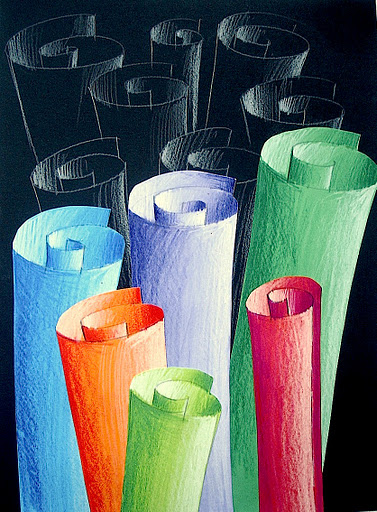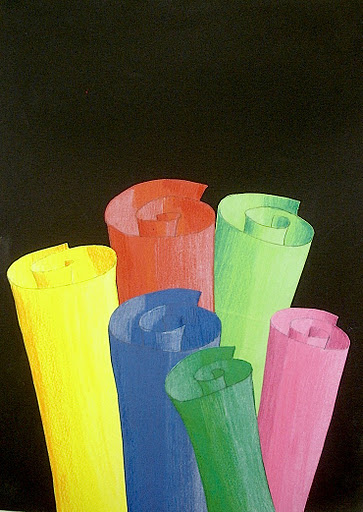I used simple cardboards, black and coloured, even sheets of coloured papers could be good. First, I drawn the scrolls on the coloured cardboards with a pencil. Second, we colored the scrolls with colored pencils: a darker tone for the shaded area, a lighter color for the highlight areas and a white pencil for the most enlightened, using different pressures to create a gradient. Then you cut the scroll’s shape and eventually paste it on the black cardboard. You can also show to your pupils the effects of light and shadow rolling up a piece of cardboard and illuminating it with a light side. They can understand better where are the lights and the shadow.
Realizzati su cartoncini colorati questi esercizi fanno comprendere la direzione della luce e delle ombre in un oggetto abbastanza complesso, come un foglio arrotolato o un nastro. Una volta colorate le ombre con le matite colorate e le luci con un pastello bianco, la forma viene ritagliata e incollata su un cartoncino nero, per dare ancora più profondità alla composizione.




Holy smokes, these are amazing! Were the drawings done on white or coloured paper? What age group made these? Beautiful and dramatic!
Hi Miss!We have done these on coloured paper, doing the lights with white pastel and the shadows with the darker colour (dark green on green paper…). Then we’ve cut the shapes and sticked on black cardboard.You can draw the same shape on the black background with white pastel, to increase the depth.
I made with pupils of Year8, 12-13 years old, after the lesson of light and shade effects on solid figure (bottle, sphere, vase, fruit…) in the still life.
Thanks Miriam. Year 8!! Fantastic-you have very talented students (and a great teacher, too, I'm sure 😉
Again!!! This is a great lesson. You are wonderful! You asked a bit bout my latest post, the face sculpture. http://minimatisse.blogspot.com/2012/01/8th-grade-face-sculptures.htmlI had to look up what vinilic glue is. I think it is like our white liquid glue. The paste I used is called Elmer's Art paste. https://www.etriarco.com/triarco/#&&/wEXAgUNaW5wdXRBcmd1bWVudAXoAUFBRUFBQUQvLy8vL0FRQUFBQUFBQUFBTUFnQUFBRVJEYjI1MFlYUmhMbGRsWWl3Z1ZtVnljMmx2YmoweExqQXVNVFkxTGpBc0lFTjFiSFIxY21VOWJtVjFkSEpoYkN3Z1VIVmliR2xqUzJWNVZHOXJaVzQ5Ym5Wc2JBVUJBQUFBSTBOdmJuUmhkR0V1VjJWaUxsQnliMlIxWTNSRVpYUmhhV3h6UVhKbmRXMWxiblJ6QVFBQUFCbzhVSEp2WkhWamRFbGtQbXRmWDBKaFkydHBibWRHYVdWc1pBQUlBZ0FBQUdkc0FBQUwFC2NvbnRyb2xOYW1lBRNQcm9kdWN0RGV0YWlscy5hc2N4nxTCOjDAI0d/nkIndvct17JvoVM=This product is slimy and the kids love it! I did use a matte board template because it is a nice, stiff base. Cardboard for the 3-D parts because they are able to cut out with a scissors rather then a knife. They taped these parts on and covered with a light paper (newspaper, tissue paper, even toilet paper) mixed with the art paste. This project took about 8 hours to finish. I'm going to update my post for your question. Others might be wondering some of the same things. Thanks for your comments!
Thanks so much for sharing this lesson. I did it with my students and I loved the results. YOu can see them here: http://artwithmrssmith.blogspot.com
great work! I’m so excited to share my ideas with other teacher around the world!!! Your student are very gifted! Thanks for sharing